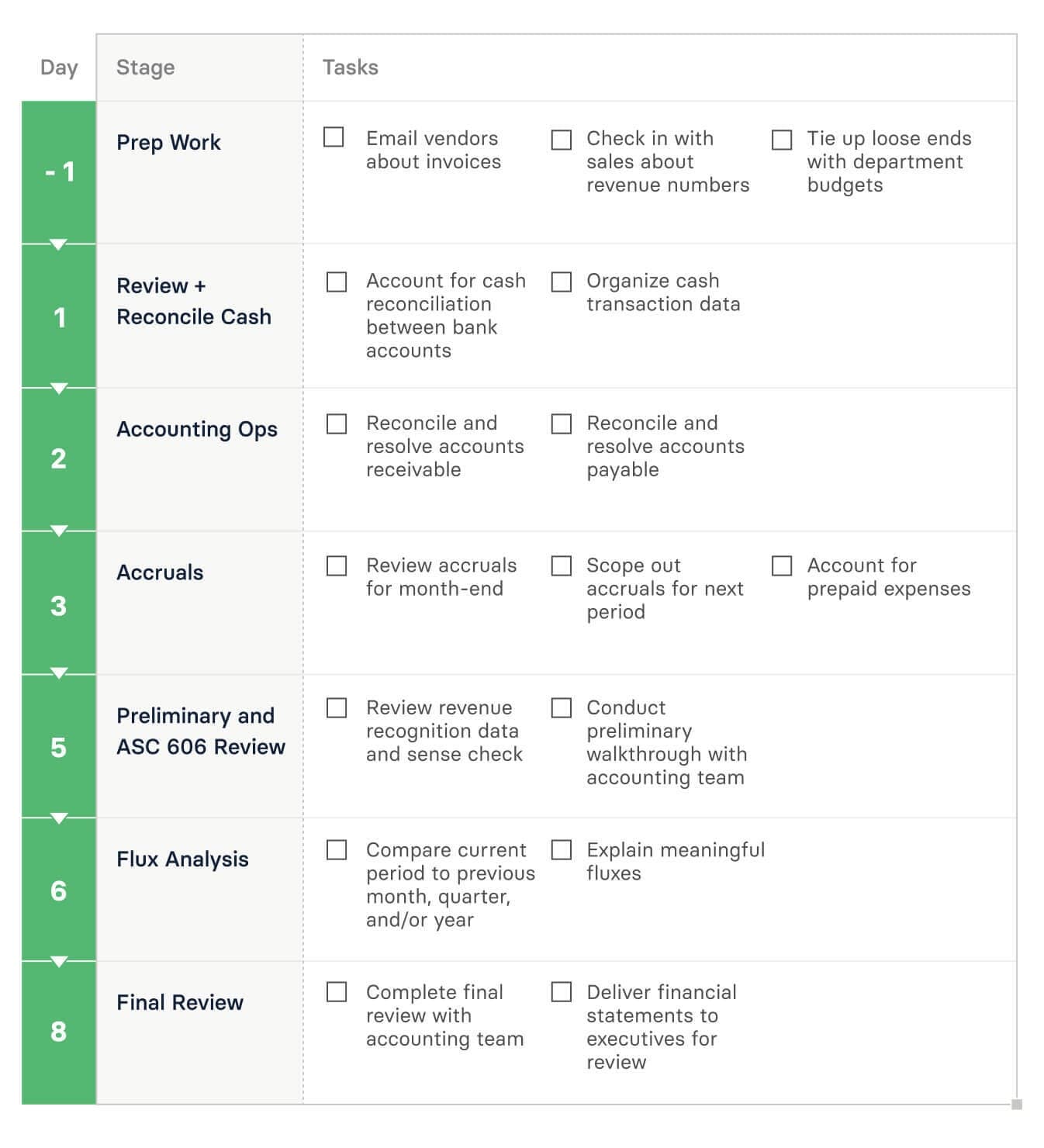The month-end close process is crucial to the financial health of a business—not just because it’s responsible for maintaining long-term financial integrity, but because it creates the foundation for CFOs and finance teams to analyze numbers and find growth opportunities.
But it’s also one of the most time-intensive and tedious business processes.
In an episode of The Role Forward, Temi Vasco, Controller at Gem, emphasized how an efficient month-end close process helps leaders make better-informed business decisions and frees up finance and accounting to focus on more forward-looking, strategic tasks.
Reducing the close times from 3 weeks to as few as 5 days comes down to automating repetitive tasks and having a solid month-end close process checklist in place. Here’s how you can get through your month-end close process more efficiently. (And be sure to download the full month-end close checklist template to streamline your process.)
Table of Contents
What Is the Month-End Close Process?
The month-end close process involves accounting teams collecting, reviewing, and conforming transactions and financial activity from the previous month. It is used to ensure accuracy and compliance while maintaining data integrity for financial planning and analytics.
While there’s a certain level of predictability in expenses and transactional activity, each month may come with new wrinkles to account for. This is why Vasco emphasizes that the month-end close needs to have a firm sense of flow—from the moment the team starts to gather information to when it crosses the finish line with finalized financial statements.
Month-End Close Checklist: 7 Steps to Nail Your Close Process
Every accounting team should have a documented month-end close checklist to follow month in and month out. This is one of the most repetitive processes you’ll go through — but you can’t get complacent and let the small details slip.
Your checklist doesn’t have to be overly complicated. But you should be able to verify that each piece of the puzzle has fallen into place as you close the books each month.
Here’s a simple list of what you should include in your month-end close checklist.
1. Prep Work
The first step of a month-end close checklist comes before the end of the month. It’s when you start tying loose ends across the business and with vendors so you have all the right information in place when that period turns over. Your prep work should include the following.
Email vendors about invoices
Send emails out to both employees who own vendor relationships and the vendors themselves about any missing invoices. You want all the necessary information on hand when you start closing the books.
Review revenue numbers with sales
Align with sales and sales ops leaders to get a basic idea of where the revenue numbers will fall for the month. Be sure to have sales ops clean up any data entry issues before you start closing the books.
Review department budgets
Make sure data is accurate on department budgets and tie up any loose ends regarding planned expenses.
2. Review and Reconcile Cash
At the end of each month, you need to upload all cash transactions from the prior period in your ERP. Then, review cash transactions and reconcile bank balances if necessary.
Clean up prepaid expenses
Review any new prepaid expenses and ensure the entries are accurate. You should also remove any prepaid expenses that have fully amortized.
Update fixed asset amortization
Record ASC842 lease amortization and reconcile your accounts. You should also record any depreciation for equipment and classify expenses over capitalization threshold accordingly.
3. Reconcile Accounts Receivable and Accounts Payable
A large chunk of the month-end close is recording and reconciling the accounts receivable (AR) and accounts payable (AP) sides of the business. Here’s what you need to get done:
- Record revenue share for closed-won deals
- Post revenue recognition entries to your ERP
- Sense check revenue numbers based on prior month
- Review financial statement fluxes and six-month trend reports for reasonableness
- Review operating expense accounts and book any necessary reclassifications.
4. Manage Accruals
Assuming you’re working with accrual accounting, you’ll have to ensure accrued expenses are recorded properly. Once all actuals have synced with your ERP, you can:
- Record accrual estimates for sales commissions and bonuses that will be paid out quarterly
- Record all accrued expenses and revenue in your ERP and check the schedule for accuracy
- Finalize and record journal entries for debooked deals, deferrals, and credit memos.
5. Revenue Recognition Review
After completing AR reconciliation and accrual reviews, check your revenue postings for accuracy. Take the necessary steps to ensure you’re adhering to the new guidelines in ASC 606 for revenue recognition.
6. Conduct Flux Analysis
At the end of your closing processing, you should be conducting a flux analysis of the current period versus last month. Check your month-end close findings against company growth goals and expectations. If something doesn’t quite look right, it’s important to flag that to the business.
7. Complete Final Review
You shouldn’t be running your month-end close in a vacuum. It’s important to work with the finance team to pull flux analysis forward into variance analysis for all P&L and balance sheet accounts. Update the team on year-to-date spend reports and provide a strategic narrative around the prior month’s performance.

Repetitive Tasks That You Can Automate in Your Month-End Close Process
Business owners can’t forecast the future until they know the actuals from the prior period. The longer your bookkeeping takes, the staler the financial data gets, which hurts the accuracy of any forecast.
Business partners are no longer content with long reporting cycles—they want faster insights from financial information. And you get faster insights by automating tedious, time-consuming tasks.
Finance and accounting need to find any and all opportunities to automate tasks in the monthly closing process. This is what frees their time to not only close faster, but contribute to larger conversations around strategic business goals. These are some common ways to use SaaS accounting software, financial close software, and other tools to automate aspects of your month-end close process.
Emails and Reminders
The month-end process starts just before the end of each month, when you’re doing prep work like wrapping up outstanding vendor invoices.
Close management solutions and other SaaS accounting software like FloQast offer reminder features that automate emails to vendors to ask for invoices or anything past due. Instead of manually running through a list of vendors to contact and sending out templated reminders, automating the process lets you focus on more valuable prep work.
Marketing Alignment
Knowing about the major one-off expenses coming down the pipeline is crucial for marketing, finance, and accounting alignment. But trying to chase down updates in Slack messages, via email, or in person can slow you down.
Calendar systems like ClickUp, CoSchedule, or Monday.com give all necessary teams visibility into what the marketing team needs regarding vendors for upcoming events or collateral for product launches and announcements. The calendar serves as a timeline for confirmations and setting budget expectations, which can be accounted for as you approach your month-end close or forecast future closes.
Purchase Orders
Department heads know what tools and systems they need to be successful–and these tools and systems can be changed or updated between month-end closes. If finance and accounting miss out on conversations with department leaders over these updates, they end up with holes in the numbers. Automating purchase orders fills that gap.
Automating your procurement process with accounting systems like Accrualify streamlines organizing your accruals and accounts payable and promotes enhanced transparency and efficiency.
No one has perfected accrual automation. But these kinds of tools can help you get to follow-up conversations faster so you can clarify whether unusual purchase orders will be continual expenses that you accrued or if they’re one-time purchases to note and forecast for next month.
Revenue Recognition and ASC 606
Keeping track of revenue from product sales and services ensures that your business is on track with your forecasted ARR and sets you up for compliant tax filings later. Tools like SaaSOptics automate revenue schedules through CRM integrations and sync invoices to your general ledger chart of accounts structure so you can handle revenue recognition with minimal manual input.
Board Reports and Fluxes
Efficient month-end closes are the foundation for strong board reporting and insightful flux analysis. Inaccuracies and delays in the close will derail each of these processes, hurting your standing with investors as you struggle to explain the “why” behind your numbers.
You need to know exactly where things stand to offer accurate reports to your board leaders and executive suite. Vasco noted how Mosaic has been instrumental in building out quarterly board decks and running flux analysis to compare financials period over period.
Mosaic offers an analysis canvas that automatically aggregates finance and accounting data from multiple systems of record, so you can easily compare your budget versus actual spend for the month and inform future spend forecasting.
How to Automate Financial Close & Consolidation
Mosaic Can Drive a More Efficient Month-End Close Process
No matter what your bespoke month-end close process looks like, data availability and integrity will make or break its effectiveness. If your accounting department is bogged down with manual data entry, sorting, and Excel spreadsheets, they’re bound to get caught in a vicious cycle of never-ending, backward-looking reporting.
Mosaic isn’t a close automation solution—but its ability to integrate data from all of your systems of record in real time satisfies those two prerequisites for better accounting procedures and an efficient month-end close process. With Mosaic in place, multiple steps in the month-end close become significantly easier, including:
- Sense-checking ARR numbers based on prior period revenue
- Running flux analysis and quickly creating explanations for discrepancies
- Reviewing operating expense accounts and identifying necessary reclasses
- Creating quarterly board materials
- Collaborating with executives and key stakeholders to review balance sheet statements, cash flow statements, and income statements.
If you want to learn more about how Mosaic helps finance and accounting teams assume a more strategic role in the business, reach out for a personalized demo. Or, download this month-end close checklist template and put yourself on the path to a 5-day close.
Month-End Close Process and Checklist FAQs
What should your month-end reports contain?
Monthly closing reports should contain financial reports divided into categories, such as:
- Revenue
- Liabilities
- Assets
- Operational data
Month-end reports should also contain a month-over-month comparison of important business metrics to evaluate performance comparing current month to the previous month.
How long should my month-end close process take?
What is the difference between a month-end close and a year-end close?
Own the of your business.

